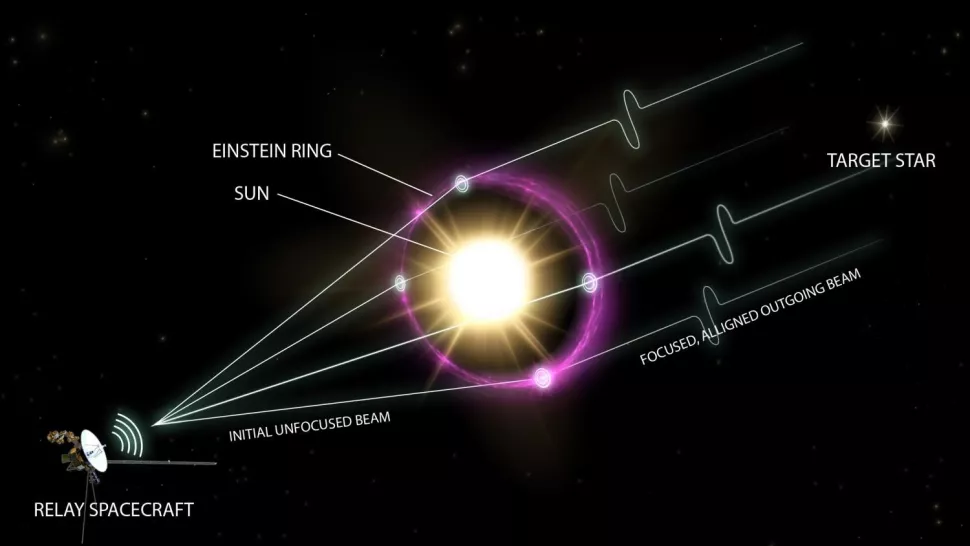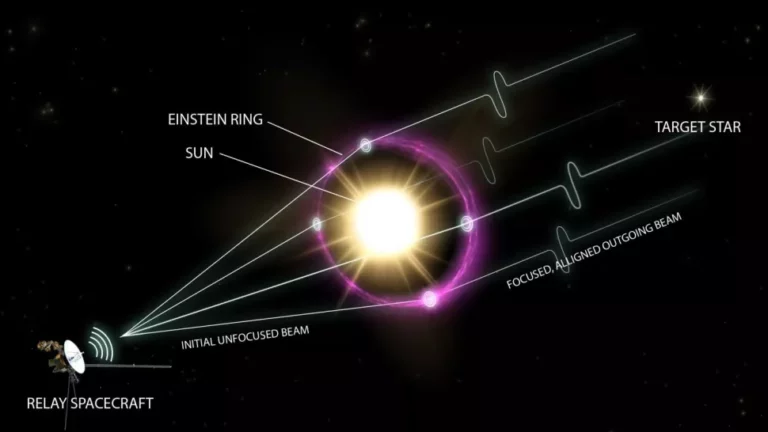Could signals transmitted around the sun be used to listen in on extraterrestrial conversations?
We’d also be able to communicate with our own interstellar probes using the same method.
The ability to recognize signals from advanced alien civilizations may have been improved.
Light may be bent by the gravitational attraction of large astronomical objects, according to Einstein’s general relativity theory. When it accomplishes this, a phenomenon known as gravitational lensing occurs that focuses and enlarges light like a telescope. However, this process may not just have an impact on visible light.
Graduate students at Penn State who are taking a course on the search for extraterrestrial intelligence (SETI) propose that gravitational lensing may also be used to amplify communication signals. And if that’s feasible, we could even be able to listen in on messages being transmitted by extraterrestrials circling the sun.
According to their hypothesis, massive interstellar communication networks may employ gravitational lensing to relay transmissions across long distances, much to how cellular networks work on Earth.

According to a comment from a course participant named Nick Tusay, “Humans utilize networks to communicate around the world all the time” . The electromagnetic waves from your telephone are sent to the closest cellular tower, which is connected to the next tower, and so on.
They might serve as relay nodes for this communication network if probes are placed in certain locations close to stars to take use of their gravitational lensing. The students contend that humanity would be able to detect those signals if a sophisticated extraterrestrial culture had discovered this technique and was utilizing the sun as a relay station.
By gathering data from the Green Bank Telescope in West Virginia and looking for radio broadcasts that may have been transmitted from our closest star neighbors, which are situated in the Alpha Centauri system, they investigated this idea.
According to a statement from Macy Huston, another student in the course, “there have been a few prior searches using optical wavelengths, but we opted to utilize radio wavelengths since radio is an excellent means to relay information across space.”
Even though the students were unable to find any extraterrestrial communications, there is still some optimism. Since we only had one night to do our search, Tusay explained, “anything that wasn’t transmitting when we were monitoring was not going to get picked up.” This was an excellent test to determine if this type of search is feasible, even if our narrow search may miss existing probes if they weren’t continuously broadcasting at these frequencies.
The organization also hopes that future course participants will keep listening for extraterrestrial broadcasts, although gravitational lensing has applications that go beyond looking for extraterrestrial life.
According to a statement from the course’s instructor and director of The Penn State Extraterrestrial Intelligence Center, Jason Wright, “Astronomers have thought about using gravitational lensing as a technique to basically create a huge telescope to look at planets surrounding distant stars.” It has also been thought of as a potential method for human communication with probes that we could send to other stars in the future.
A paper describing the technique has been accepted for publication in The Astronomical Journal, and a preprint version(opens in new tab) is available via the arXiv database.




I’m really happy to say it was an interesting post to read.
I learned new information from your article,
you are doing a great job.